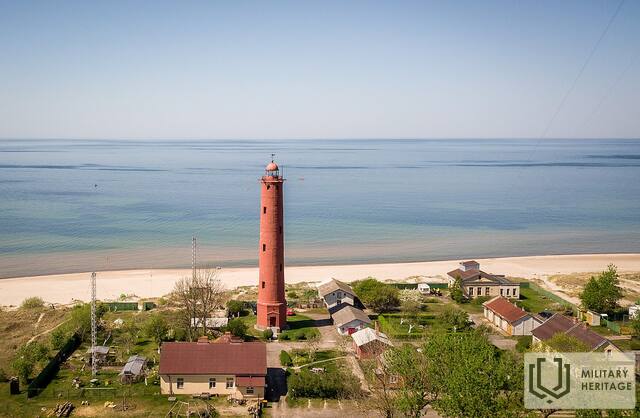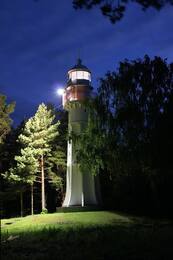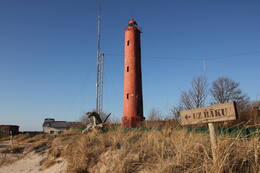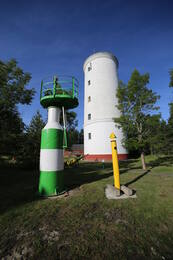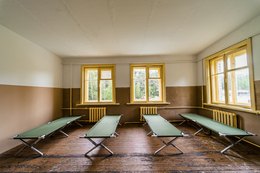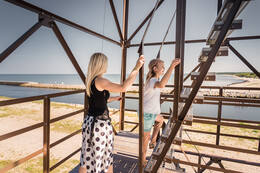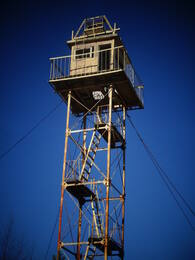Prohibited lighthouses and the sea shore
PSRS laikos jūras piekraste Ziemeļkurzemē un Rietumkurzemē faktiski bija apmeklējumam slēgtas militāras zonas, bet bākas apmeklēt un pat fotografēt bija aizliegts
Kad jūras vēstures un bāku pētnieks Arvis Pope nolēma uzrakstīt savu pirmo grāmatu par bākām, viņam nācās apbraukāt ar īpaši izsniegtu atļauju aizliegto Kurzemes jūras krastu un, protams, ka gribējās bākas arī nofotografēt. Taču oficiāli tas bija liegts, jo bākas bija militāri objekti, tās uzraudzīja robežsargi un tā laika drošības struktūras. Nācās to mēģināt darīt slepus, pašam esot krūmu un meža koku aizsegā. Pie tam fotofilmas bija steigšus jāmaina un jāpaslēpj. Vārdusakot, jārīkojas gluži kā spiegu filmās. Jo bāku tuvumā atradās robežsargu daļas un kā izrādās, pat Kolkas ragā ar fotoaparātu rādīties nebija ieteicams.
Pāvilostas pusē esot bijis tā – Arvis jautājis kādam vīram, kurš darbojies ar slotu – sak, kur te var iziet un droši pastaigāt pa jūras malu? Vīrs viltīgi pasmaidījis un teicis - ja iesi pa labi, tur pabrīdinās un tad šaus. Bet ja iesi uz otru pusi- tur šaus bez brīdinājuma, tur ir raķešnieki!
Turpat Pāvilostā iegājuši grāmatnīcā un ieraudzījuši uz plaukta Latvijas karti. Tā kā pašiem tā bijusi jau pamatīgi noplīsusi un nolietota, nolēmuši nopirkt sev jaunu. Un kaimiņam Rīgā arī vēl vienu paņēmuši. Kad izgājuši no grāmatnīcas, nejauši atskatījušies un pamanījuši pārdevēju veikala logā. Tā jau ar kādu runājusi pa telefonu, turpinājusi uzmanīgi vērot svešos pircējus un pierakstījusi atbraucēju automašīnas numura zīmi.
Arvja Popes grāmata par bākām Zvaigznes krastā iznāca 1985. gadā un kā par brīnumu, bāku bildes grāmatā bija palikušas necenzētas. Laikam jau cenzētāji bijuši nekompetenti bāku slepenības jautājumos.
Saistītās laikalīnijas
Saistītie objekti
Mērsrags lighthouse and former border guard
Mērsrags Lighthouse is located in the Mērsrags village, about 1 km north of the village centre. The lighthouse was put into commission in 1875. It is an 18.5 m tall freestanding, cylindrical, riveted iron tower, the lower part of which has been fortified with reinforced concrete counterforts. The height of the signal light is 21.3 m. At the top all around the tower there is an iron balcony supported by consoles. The lighthouse tower was made by Sotera, Lemonier & Co in Paris, so this lighthouse is commonly known as the ‘Frenchie’. At the end of 1944, the 1003rd Artillery Division Battery of the German Army with 60 cm spotlights was located right next to the lighthouse. In May 1945, the Nazi Germany high command planned to move the 15th Latvian SS Grenadier Division to the area, but these plans failed, because Latvian soldiers surrendered to the Western Allies. Near the Mērsrags Lighthouse there are still remains of a building where during the USSR times Soviet border guards had a large, extendable spotlight for illuminating the sea. There is a bird-watching tower next to the lighthouse. Tours need to be booked beforehand by contacting the Mērsrags Tourism Information Centre.
Akmeņrags Lighthouse and the fate of the "Saratov"
The Akmeņrags Lighthouse is located in Saka parish, 10 kilometres southwest of Pāvilosta. The top of the lighthouse can be reached by a spiral staircase and it offers views of the sea and the surrounding forests. Standing at 37 metres high, the current lighthouse tower was built in 1921, while the previous lighthouse was destroyed during World War I.
The Akmeņrags Lighthouse stands out among other lighthouses in Latvia, as it is located in one of the most dangerous places for sailing in the entire Baltic Sea coast. The signal beam of the lighthouse marks a rocky bank, which extends approximately two nautical miles or 3.7 kilometres into the sea in a north-western direction. The depth of the bank is just over two metres. The location of the lighthouse has remained unchanged, but the coastline has been receding over the years. Although a navigation light has been here since 1879, Akmeņrags has seen several shipwrecks. The most notable occurred in September 1923 when a Latvian steamer named Saratow struck the ground. In 1919, Saratow briefly served as the seat of the Latvian Provisional Government. Akmeņrags used to be home to a border guard post, and buildings of the Soviet Army are can be viewed here.
Oviši Lighthouse and Soviet border guard
Oviši Lighthouse is located in the Tārgale parish in a village called Oviši on the coast of Kurzeme. It was built in 1814 and it is the oldest lighthouse in Latvia. The height of Oviši Lighthouse tower is 37 m. The lighthouse has a double-cylinder design: its diameter is 11.5 m, but within the stone wall there is a second tower with a diameter of 3.5 m. Such double-cylinder lighthouses were used also as defensive structures in the 18th-19th century Europe in case of enemy attacks. The Oviši Lighthouse Museum is considered to have the largest collection of lighthouse equipment and maritime navigation items among all Latvian lighthouse museums. When the weather is right the Irbe Lighthouse can be seen from Oviši Lighthouse.
At the end of World War II, the headquarters of the Beminger Battalion of the German Army was located near the Oviši Lighthouse along with the 4th Battery of the 530th Naval Artillery Division with several anti-aircraft guns. It is said that there was a radio direction finder and an infrared ray detection station Donau Gerät located at the foot of the lighthouse. A Soviet border guard post was once located near the lighthouse, but none of the Soviet-era buildings have survived. The Oviši station building is still located in the territory of the lighthouse.
Militärstützpunkt der sowjetischen Armee in Pāvilosta - aktives Erholungszentrum
Während der Sowjetzeit war hier eine Grenzschutzeinheit stationiert, andere Einheiten der sowjetischen Armee - Verbindungsoffiziere und eine Boden-Luft-Raketenbasis - befanden sich einige Kilometer entfernt im Wald. Nach der Unabhängigkeit war dort die lettische Armee stationiert.
Der ehemalige Militärstützpunkt der Sowjetarmee ist heute ein Erholungs-, Freizeit- und Campingzentrum - für die persönliche Entwicklung im Umgang mit der Natur und den Menschen in der Umgebung.
Ein Ort der Erholung und Unterkunft sowohl für Touristengruppen als auch für Familien. Zimmer, Duschen, WC, Kamine, großzügiges Gelände für Aktivitäten, Naturgeräusche. Reservieren Sie im Voraus unter der Telefonnummer +371 26314505.
Wachturm des sowjetischen Grenzschutzes – heute Aussichtsturm Pāvilosta
Der Wachturm des sowjetischen Grenzschutzes liegt an der südlichen Mole von Pāvilosta. Der ehemalige Beobachtungsturm des sowjetischen Grenzschutzes, der seit Anfang der 1990er Jahre nicht mehr genutzt wird, verfügt heute über eine Aussichtsplattform mit einem um 360 Grad drehbaren Fernrohr. Von hier aus bietet sich ein schöner Blick auf das Meer und die Schiffe. Auch lassen sich von hier aus gut Vögel beobachten. Der Turm ist nur im Sommer und nur bei Tageslicht geöffnet. Das Betreten erfolgt auf eigene Gefahr, insbesondere in Anbetracht der steilen Treppe. Der Turm und seine Umgebung sind videoüberwacht. Im Winter ist er nicht zugänglich.
Grenzwachturm in Mazirbe
Zur ehemaligen Marineschule Mazirbe gehörte ein Stützpunkt des sowjetischen Grenzschutzes mit einem bis heute gut erhaltenen Wachturm. Ein weiterer Beobachtungsturm befindet sich direkt am Strand in der Nähe des Parkplatzes. Die Türme sind Relikte aus der Zeit der sowjetischen Besatzung, als Mazirbe zum grenznahen Sperrgebiet gehörte. Zivilisten durften damals nur bestimmte Strandabschnitte betreten und dies auch nur tagsüber. Der ehemalige Wachturm des Grenzschutzes ist einer der besterhaltenen in Lettland. Betreten auf eigene Gefahr!




